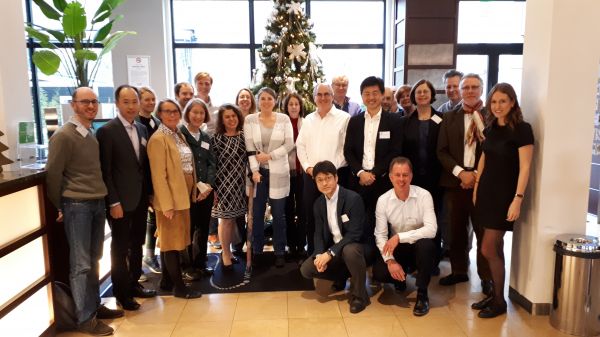Clinicopathological Classification of Dermatomyositis
- Number 239
- Date 14 December 2018
Location: Hoofddorp, The Netherlands
Title: The 239th ENMC workshop on "The Clinicopathological Classification of Dermatomyositis”
Date: 14-16 December 2018
Organisers: Dr Y. Allenbach (France), Prof. O. Benveniste (France), Dr A. Mammen (U.S.A), Prof. W. Stenzel (Germany)
Translations of this report:
Spanish by Dr A. Selva O Callaghan
Dutch by Ms. I. de Groot and Prof. M. de Visser
Czech by Prof. J. Vencovský
Deutsch by S. Schlüter und Dr. A. v. Moers
Participants: Dr Y. Allenbach (France), Prof. O. Benveniste (France), Prof. J. de Bleecker (Belgium), Dr O. Boyer (France), Prof. L. Casciola-Rosen (U.S.A.), Dr L. Christopher-Stine (U.S.A), Dr J. Damoiseaux (The Netherlands), Prof. M. Fujimoto (Japan), Dr C. Gitiaux (France), Ms. I. de Groot (The Netherlands), Dr J. Lamb (United Kingdom), Dr O. Landon-Cardinal (Canada), Prof. I. Lundberg (Sweden), Dr A. Mammen (U.S.A.), Dr I. Nishino (Japan), Dr J. Radke (Germany), Dr A. Selva-O´Callaghan (Spain), Prof. W. Stenzel (Germany), Prof. J. Vencovksi (Czech Republic), Prof. M. de Visser (The Netherlands), Dr G. Wang (China), Prof. L. Wedderburn (United Kingdom) and Dr V. Werth (U.S.A.)
The 239th ENMC workshop on the “Clinicopathological Classification of Dermatomyositis” brought together experts in the field of myositis from Europe, Japan, China, Canada and the USA. Neurologists, Rheumatologists, Dermatologists, Neuropathologists and Myopathologists discussed and renewed the diagnostic criteria of dermatomyositis (DM) based on recent advances in the field. All experts agreed on the importance of mandatory testing of myositis specific autoantibodies (MSA, e.g. TIF-1γ, Mi-2, NXP2, MDA5 and SAE) in the diagnostic workup of DM patients. Furthermore, they emphasized the importance of autoantibodies to define certain subtypes of DM, which may have a characteristic clinical, pathological and even histological appearance. If the clinical presentation of a patient is classical, consisting of characteristic, DM-associated skin changes (e.g. DM-like rash), muscle weakness and detection of any MSA, the diagnosis of DM may be made, even without a muscle biopsy. Moreover, the finding of characteristic skin changes, clinically and in a skin biopsy, in combination with MSA but without muscle affection is also compatible with the diagnosis of DM. A more detailed definition of DM-like skin changes and histological criteria seen in the skin biopsy of an affected skin area in a DM patient will soon be published by an international expert team of dermatologists. It was clear to all experts that the muscle biopsy was and still is a very valuable tool and the gold standard in the diagnostic routine. Novel, specialized immunohistochemical stains further increase the certainty of a correct histological diagnosis. Especially in TIF-1γ positive DM patients, the muscle biopsy combined with the patients´ age may help to stratify patients concerning their risk of already having or developing a malignancy. It became clear, that TIF-1γ should not be misinterpreted as a bona fide tumor marker. However older patients with TIF-1γ positive DM definitely need an oncological screening in routine care since cancer risk is prominently elevated.
Additionally, the classification of the Anti-synthetase syndrome (ASS) was a matter of debate. Recent scientific data presented in the ENMC workshop clearly highlighted the differences of DM and ASS. All experts agreed on ASS being a distinct subtype, pathophysiologically clearly different from DM. Nevertheless, ASS can in very rare cases be considered as DM-related.

A full report is published in Neuromuscular Disorders (pdf).
